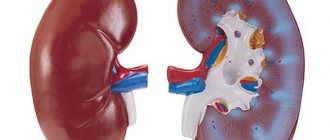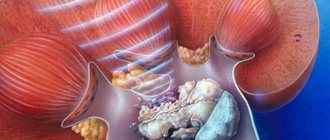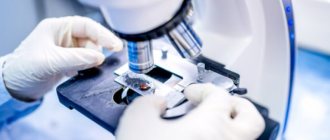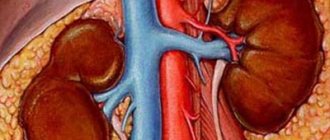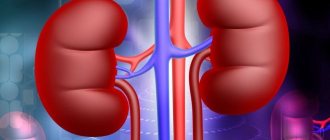How does hemodialysis work?
Vascular access is required to connect to the artificial kidney. For this purpose, a small surgical intervention is performed on the forearm in advance - an arteriovenous fistula is formed. This is the suturing of an artery and a vein. After the operation, a superficially located vessel with a sufficiently high blood flow rate and a thick wall is obtained. The fistula needs about 1 month to “mature”, i.e. form after complete healing.
During the dialysis procedure, a needle is inserted into the fistula with a flexible tube connected, through which blood flows into the dialysis machine. There, toxins, excess electrolytes and fluid are removed. After this, the blood is returned to the patient’s vascular bed. To prevent the blood from clotting and clogging the dialysis system with blood clots, heparin is administered. In emergency cases, when there is no ready access, a catheter is installed in a large vessel for the patient. Hemodialysis is done three times a week, on average the procedure takes 4 hours. All this time the patient lies in a functional chair, connected to the device; you can read, watch TV, sleep, listen to music.
Diagnostics
The main factor is considered to be an increase in potassium and nitrogen compounds in the blood against the background of a significant decrease in the amount of urine released by the body and the state of anuria. The volume of daily urine and the concentration functioning of the kidneys are assessed using the Zimnitsky test. Monitoring of blood biochemistry characteristics such as urea, creatinine and electrolytes is essential. These characteristics make it possible to assess the severity of acute renal failure and the outcome after the necessary therapeutic actions.
The main problem in the diagnosis of acute renal failure is the establishment of its form. For this purpose, an ultrasound of the kidneys and bladder is performed, which makes it possible to identify or exclude obstruction of the urinary tract. In some cases, bilateral catheterization of the pelvis is carried out. If, in this case, two catheters easily pass into the pelvis, but the release of urine through them cannot be traced, the postrenal form of acute renal failure can be eliminated with complete confidence.
At a later stage, acute renal failure is diagnosed according to test criteria, which are determined by a specialist after a comprehensive examination.
If necessary, assess renal blood flow by performing an ultrasound scan of the renal vessels. Suspicion of tubular necrosis, acute glomerulonephritis, or systemic disease is considered an indication for a kidney biopsy.
After laboratory diagnosis of acute renal failure, emergency therapy is the first thing to be done so that the patient’s condition does not worsen.
Indications for starting hemodialysis
Hemodialysis is performed for acute kidney injury and chronic renal failure. Since acute damage can be reversible, only a few procedures are required in this case, usually from 2 to 5. With the restoration of kidney function, hemodialysis is stopped.
In case of chronic failure or acute injury with an unfavorable outcome, the kidneys completely cease to perform their functions. This occurs due to the death of the renal glomeruli and their replacement with scar tissue. In this case, hemodialysis replaces the work of the kidneys and is carried out until the transplantation of a donor organ or until the death of the patient.
Indications for the start of the procedure are determined by a nephrologist. The specialist primarily focuses on the patient’s condition, but also takes into account the test results. Symptoms that indicate the need to start dialysis as soon as possible in patients with severe kidney disease:
- brain dysfunction due to exposure to uremic toxins
- inability to control blood pressure
- severe acid-base imbalance
- uncontrolled swelling with risk of developing cerebral edema or pulmonary edema
- progressive weight loss
- severe nausea, vomiting, general weakness
- painful skin itching, deposition of toxins on the serous membranes of the body
- increase in potassium level above 6.5 mmol/l
- decrease in glomerular filtration level to less than 10 ml/min.
Surgical treatment of chronic renal failure, kidney transplantation for chronic renal failure
Hemodialysis therapy is an effective means of prolonging life in patients with the kidney pathology in question.
However, it has a number of disadvantages, including dependence on the dialysis center. Missing even one procedure can cause the death of the patient. In this regard, the popularity of kidney transplantation for chronic renal failure is increasing every year: this can significantly facilitate and prolong the patient’s life.
The indication for this surgical intervention is the inability of both kidneys, or a single kidney, to carry out the work of cleansing the blood of toxins.
The reasons for refusing to carry out this operation are the following conditions:
- Oncological diseases.
- Tuberculosis is in the active stage of development.
- Serious errors in the functioning of the cardiovascular system.
- Mental disorders.
- A lung disease that is chronic in nature and is accompanied by respiratory dysfunction.
- AIDS.
- Viral hepatitis.
It is also inappropriate to perform kidney transplantation in patients with any diseases in which the prognosis of life is limited to 2 years.
The kidney can be transplanted from a living donor—or a deceased person. The first option is more common in the world. In such a situation, the donor has time to conduct a comprehensive examination, and the patient has the opportunity to avoid dialysis therapy, which is fraught with a number of negative consequences.
In addition, while waiting for a kidney transplant from a deceased person, the patient is put on a waiting list. He can wait for his turn for more than one year, and the procedure itself is carried out unscheduled. During the waiting period, hemodialysis is prescribed and chronic ailments (if any) are treated.
The operation in question requires the use of general anesthesia, and can be performed using 2 methods:
- Orthotopic transplant . The diseased kidney is removed and a donor kidney is placed in an identical location. The vessels of the transplanted organ are sutured to the vessels of the native kidney. This technique is rarely practiced due to a number of disadvantages.
- Heterotopic transplantation . The center of manipulation is the iliac zone of the small pelvis. The recipient's blood vessels are sutured to the vessels located in the iliac zone. Such manipulation is technically easier.
One of the most severe complications of the postoperative period is donor organ rejection. This phenomenon is accompanied by severe pain in the lumbar region, a strong increase in body temperature, retention/absence of urine, etc.
The thing is that the donor organ is perceived as a foreign body, and the body begins to actively produce antibodies. Therefore, it is very important to take immunosuppressants after the operation in question.
Among other things, the quality of graft survival largely depends on the selected donor and his immunological compatibility with the recipient. The best option is an identical twin. Second place is taken by siblings, followed by parents and other relatives.
The chances of survival of a cadaveric organ are less than those of a kidney taken from a living unrelated donor.
Of no small importance is the age of the donor and recipient, the quality of preparation for surgery, as well as the reputation of the organ transplant center.
Video: Kidney transplantation
Contraindications to the hemodialysis procedure
Contraindications are currently reduced to a minimum - these are acute cerebrovascular accident, bleeding, a general serious condition caused by heart failure or cancer, and mental illness (not associated with brain damage from uremic toxins). However, even these contraindications are considered relative, i.e. In certain clinical situations, the patient may be started on hemodialysis if the potential benefit of the procedure is obvious.
Postrenal causes
The postrenal form of renal failure may occur in the following cases:
The basis of the disease is a variety of disorders, which are characterized by the presence of disturbances in the renal blood flow, a decrease in the level of glomerular division passing through the walls of disease-prone canals, compression of these canals by edema, possible humoral effects due to which biological substances become active, due to which damage and violations. Spasms and arterial thrombosis may occur. The changes that occur during this process most strongly affect the tubular apparatus.
Complications of hemodialysis
The most common problems are:
- increase or decrease in blood pressure
- muscle cramps
- headache
Somewhat less frequently, nausea, cardiac arrhythmias, and thrombosis of an arteriovenous fistula may occur.
To prevent complications, it is important to take prescribed medications to lower blood pressure and follow a fluid-restricted diet during the period between hemodialysis procedures. During the interdialysis period, weight gain should not exceed 5 percent of the ideal “dry” weight. If phosphorus-calcium metabolism is disrupted, it is necessary to correct the levels of calcium, parathyroid hormone, phosphorus and vitamin D3. You should not take medications that affect blood clotting on your own.
What functions do the kidneys perform?
The kidneys in the human body play a very important role in the system of urine formation, excretion and chemical homeostasis of the body; they are the main element of the urinary system, if the functioning of which is disrupted, the most tragic consequences for human life are possible.
The kidneys are involved in hematopoiesis, and also perform a number of functions of purifying body fluids: excretory (that is, excretory), osmoregulatory, ion-regulatory, endocrine (intrasecretory) and metabolic functions. They take part in liberating the human body from all accumulated toxins and harmful substances. In addition to these functions, the kidneys are involved in normalizing internal pressure. If there is a disruption in the normal functioning of the kidneys, then the entire body is poisoned by metabolic products. This condition is very dangerous for human health, even threatening the patient’s life.
Lifestyle of a hemodialysis patient
In Russia, patients with kidney failure receive dialysis treatment at public expense.
Chronic hemodialysis significantly changes the patient's life, as it requires visiting the dialysis center three times a week. Fortunately, so-called “guest” dialysis is now becoming more widespread. For example, if a patient wants to go on vacation or visit relatives in another city, he can contact the nearest dialysis center in that city in advance and ask to reserve time for the procedures. After arriving to visit, program hemodialysis is carried out not at home, but at the guest center for the entire period of stay. This is usually free for the patient; three procedures per week are paid for by the state. Payment may be required when traveling abroad, if you need to do dialysis more often, or if you travel unexpectedly without prior approval from the guest center.
Diet for hemodialysis
In order to tolerate blood cleansing well, it is important to constantly monitor your weight, not allowing a large increase in fluid between procedures, and adhere to a diet that limits foods rich in potassium (dried fruits, nuts, potatoes) and phosphorus (cheese, fish).
There are standards for protein intake. They are determined at the rate of 1.2 g of protein / 1 kg of weight per day. Half of this protein should be of animal origin. A patient weighing 65 kg should receive 78 grams of protein from food. With insufficient nutrition, exhaustion begins. In such cases, additional nutrition is needed, such as liquid formula and protein powders. If they do not have an effect, a feeding tube is prescribed, and if this does not help, then the nutrients are administered parenterally (intravenously).
Dialysis patients should not consume table salt and most salt substitutes that contain potassium, and should not eat foods prepared with significant additions of salt. Hemodialysis removes water-soluble vitamins C and group B from the body. Therefore, it is recommended to take vitamins with food: the daily intake of vitamin C is 60-100 mg, folic acid is 0.8-1 mg. Vitamin D is prescribed separately, the dose is set individually depending on the level of calcium, phosphorus and calcitriol in the blood.
Total calcium intake should not exceed 2000 mg per day, and phosphorus - 800-1000 mg.
Very often, dialysis patients develop iron deficiency anemia, which requires the administration of agents that stimulate the formation of red blood cells (erythropoietins) and iron supplements.
Prospects
Despite some difficulties, most patients on hemodialysis live a full life: they can work, study, exercise, go to the pool, and go on vacation. Currently, patients on an artificial kidney can live 20-30 years. If hemodialysis is started over the age of 75 and there is already severe heart disease, vascular disease or diabetes mellitus, the prognosis worsens.
Since life on hemodialysis is a very long time, the patient will have to accustom himself to the idea of constantly working together with the doctor and the dialysis team, as well as master self-control during the interdialysis period (this is approximately 92% of the total time available to the patient). It is very important to monitor your weight, diet, know the effect of each prescribed medication and be able to assess the criticality of any situation.
Diet for dialysis
With any type of dialysis, the patient must adhere to a salt-free diet, since salty foods cause thirst. The kidney dialysis diet also aims to limit the consumption of phosphorus-rich foods (cheese, milk, beans, nuts), as it helps remove calcium from the bones. At the stage of chronic renal failure at which dialysis is prescribed, patients adhere to diet No. 7G. Its main daily parameters are the average content:
- protein from 60 to 70 g;
- energy value just over 2000 kcal;
- carbohydrates about 300g;
- animal fats about 70 g;
- liquids up to half a liter;
- salt 3-4 g;
- calcium up to 1g;
- potassium up to 3 g;
- phosphorus up to 1g.
On days of dialysis, appetite may decrease, which requires increasing food intake on days free from hemodialysis.
Diet 7G provides for daily consumption:
- salt-free bread about 150 g;
- vegetable soups up to 250 g;
- lean meat and fish up to 100g;
- fermented milk drinks and milk up to 200g;
- sour cream up to 50g;
- cottage cheese up to 40g;
- one soft-boiled egg;
- potatoes up to 200 g, other vegetables up to 300 g;
- fruits and berries up to 300 g;
- sugar up to 20g;
- butter up to 20g;
- vegetable oil up to 25g.
Broths and sauces made from meat, fish and mushrooms, sausages, canned food, caviar, legumes, smoked meats, cheese, mushrooms, dried fruits, cocoa and chocolate, as well as vegetables and fruits rich in potassium and oxalic acid are strictly excluded from the diet.

